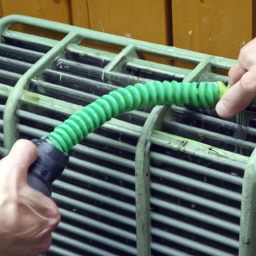How To Flush A Radiator Using A Garden Hose
Table of Contents []
How To Flush A Radiator With A Garden Hose
Introduction
Flushing a radiator with a garden hose is a simple task for anyone with basic car maintenance knowledge. It's a quick and easy way to keep your car running efficiently, and it doesn't require any special tools. In this article, we'll look at 8-12 topics related to using a garden hose to flush a radiator. We'll discuss how to siphon the old coolant from your radiator, how to flush the radiator with a garden hose, and what precautionary measures to take before and after the flush. We'll also look at popular sub-topics related to flushing a radiator with a garden hose, including what residue can be found in overheated radiators, why you should change your radiator's coolant, and the different types of coolants available.
Siphoning Old Coolant
The first step in flushing a radiator with a garden hose is to siphon out the old coolant from the radiator. To do this, you'll need to use a garden hose that's long enough to reach from the radiator to the ground. Place one end of the hose in the radiator and then put the other end of the hose in a bucket. When all the coolant has been siphoned out, the radiator will be empty and ready to be flushed.
Flushing the Radiator
Once the radiator is empty, it's time to flush the radiator with a garden hose. You'll need to attach the garden hose to a cold-water tap, and then turn on the water. Allow the water to run through the radiator for several minutes until it's clear of any residue or debris. After it's been completely flushed out, turn off the water and remove the garden hose.
Precautionary Measures
Before you begin flushing a radiator with a garden hose, it's important to take certain precautionary measures. Make sure the engine is completely cool before you open the radiator cap. Otherwise, you could cause serious damage to both your car and yourself. It's also important to wear protective eyewear and gloves to protect yourself from the radiator fluid, which can be corrosive.
Examining the Residue
When you flush a radiator, you may find residue left behind. This residue can give you an indication of what was blocking the radiator in the first place. If the residue is white, then it means it could be a buildup of calcium carbonate, which can result from the radiator's coolant breaking down. If the residue is brown or black, then it could be sludge from a dirty engine.
Changing the Coolant
When you flush a radiator, it's important to also change the coolant. Changing your radiator's coolant will help to prevent issues like calcium buildup or sludge from occurring in the future. There are several different types of coolants available on the market, so be sure to choose the one that best suits your vehicle.
Types of Coolants
The two main types of coolants are water-based and alcohol-based. Water-based coolants are the most common, and they are typically a mix of ethylene glycol and water. Alcohol-based coolants rely on methanol to keep the radiator cool, and they tend to be more expensive than water-based coolants.
Antifreeze Additives
Antifreeze additives are also available, and they can help to enhance the performance of your radiator coolant. These additives are specifically designed to reduce corrosion, enhance engine cooling, and improve the performance of your vehicle's cooling system.
Conclusion
Flushing a radiator with a garden hose is a simple task that anyone with basic car maintenance knowledge can do. In this article, we looked at 8-12 topics related to using a garden hose to flush a radiator. We discussed how to siphon the old coolant from your radiator, how to flush the radiator with a garden hose, and what precautionary measures to take before and after the flush. We also looked at popular sub-topics related to flushing a radiator with a garden hose, including what residue can be found in overheated radiators, why you should change your radiator's coolant, and the different types of coolants available. With this knowledge, you should have all the information you need to safely and effectively flush your car radiator with a garden hose.

Previous Page
Next Page